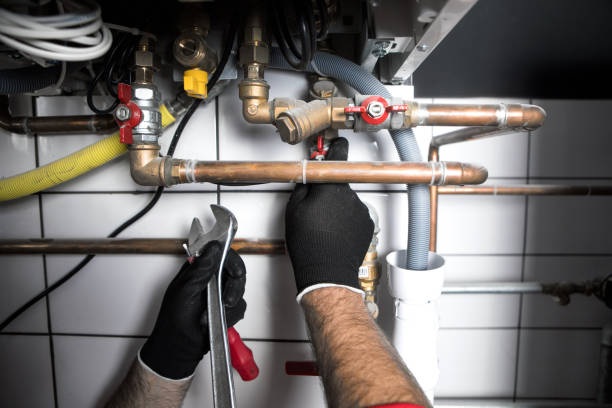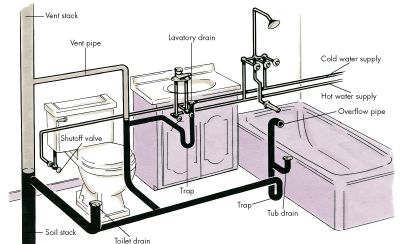How The Structure of Your House's Plumbing System Matters
How The Structure of Your House's Plumbing System Matters
Blog Article
Just how do you actually feel with regards to Exploring Your Homes Plumbing Anatomy?

Recognizing just how your home's pipes system functions is necessary for each property owner. From providing clean water for drinking, cooking, and bathing to safely getting rid of wastewater, a properly maintained pipes system is critical for your family members's health and comfort. In this comprehensive guide, we'll discover the detailed network that composes your home's pipes and offer suggestions on upkeep, upgrades, and managing common issues.
Intro
Your home's pipes system is more than just a network of pipes; it's an intricate system that guarantees you have accessibility to tidy water and effective wastewater removal. Knowing its components and just how they collaborate can assist you prevent costly fixings and make sure whatever runs smoothly.
Standard Elements of a Plumbing System
Pipes and Tubes
At the heart of your pipes system are the pipes and tubes that bring water throughout your home. These can be made from various products such as copper, PVC, or PEX, each with its advantages in terms of longevity and cost-effectiveness.
Components: Sinks, Toilets, Showers, etc.
Components like sinks, bathrooms, showers, and bathtubs are where water is made use of in your home. Understanding just how these fixtures attach to the plumbing system aids in identifying problems and intending upgrades.
Valves and Shut-off Factors
Shutoffs control the circulation of water in your plumbing system. Shut-off shutoffs are vital during emergency situations or when you require to make repair services, permitting you to isolate parts of the system without interfering with water circulation to the entire residence.
Supply Of Water System
Key Water Line
The primary water line attaches your home to the local water or a personal well. It's where water enters your home and is dispersed to different components.
Water Meter and Pressure Regulatory Authority
The water meter steps your water use, while a pressure regulatory authority ensures that water streams at a secure pressure throughout your home's pipes system, preventing damages to pipes and fixtures.
Cold Water vs. Warm water Lines
Comprehending the difference between cold water lines, which provide water straight from the primary, and warm water lines, which carry warmed water from the hot water heater, assists in troubleshooting and preparing for upgrades.
Drainage System
Drain Piping and Traps
Drain pipes carry wastewater far from sinks, showers, and toilets to the drain or septic system. Traps stop sewage system gases from entering your home and also trap particles that could trigger obstructions.
Ventilation Pipes
Air flow pipelines allow air into the water drainage system, preventing suction that might slow down water drainage and cause traps to vacant. Correct ventilation is vital for keeping the integrity of your plumbing system.
Value of Correct Drainage
Guaranteeing appropriate water drainage protects against backups and water damage. On a regular basis cleaning up drains pipes and keeping traps can avoid expensive repair services and expand the life of your pipes system.
Water Heating System
Types of Hot Water Heater
Water heaters can be tankless or typical tank-style. Tankless heating units warmth water as needed, while containers store heated water for immediate use.
Upgrading Your Plumbing System
Reasons for Updating
Updating to water-efficient components or changing old pipelines can boost water top quality, lower water costs, and increase the value of your home.
Modern Plumbing Technologies and Their Benefits
Explore technologies like smart leak detectors, water-saving toilets, and energy-efficient water heaters that can conserve cash and minimize ecological influence.
Price Factors To Consider and ROI
Determine the in advance expenses versus long-lasting cost savings when thinking about plumbing upgrades. Many upgrades pay for themselves through lowered energy costs and less repair services.
Exactly How Water Heaters Link to the Pipes System
Comprehending just how hot water heater attach to both the cold water supply and warm water distribution lines helps in diagnosing issues like not enough warm water or leakages.
Maintenance Tips for Water Heaters
Frequently flushing your water heater to get rid of debris, inspecting the temperature settings, and inspecting for leakages can prolong its life expectancy and improve power performance.
Typical Plumbing Issues
Leakages and Their Reasons
Leaks can occur as a result of maturing pipes, loose installations, or high water stress. Dealing with leaks without delay stops water damage and mold development.
Blockages and Blockages
Obstructions in drains pipes and toilets are often brought on by flushing non-flushable items or a build-up of grease and hair. Using drainpipe screens and being mindful of what drops your drains can protect against blockages.
Signs of Pipes Issues to Watch For
Low tide pressure, slow-moving drains pipes, foul odors, or unusually high water costs are indications of potential pipes troubles that ought to be resolved immediately.
Plumbing Upkeep Tips
Regular Examinations and Checks
Arrange yearly plumbing examinations to catch concerns early. Try to find signs of leakages, corrosion, or mineral accumulation in faucets and showerheads.
Do It Yourself Maintenance Tasks
Basic tasks like cleansing tap aerators, looking for bathroom leakages using color tablets, or shielding exposed pipelines in cold climates can protect against major pipes issues.
When to Call an Expert Plumber
Know when a pipes concern needs specialist proficiency. Trying complex repair work without correct knowledge can cause even more damage and greater repair expenses.
Tips for Minimizing Water Use
Simple practices like taking care of leakages promptly, taking shorter showers, and running complete lots of laundry and meals can preserve water and reduced your utility expenses.
Eco-Friendly Pipes Options
Take into consideration sustainable plumbing products like bamboo for floor covering, which is durable and eco-friendly, or recycled glass for counter tops.
Emergency situation Readiness
Steps to Take Throughout a Plumbing Emergency
Know where your shut-off valves lie and just how to turn off the supply of water in case of a burst pipeline or major leakage.
Value of Having Emergency Situation Contacts Useful
Keep get in touch with details for neighborhood plumbers or emergency services easily offered for fast action throughout a pipes situation.
Environmental Impact and Conservation
Water-Saving Fixtures and Home Appliances
Setting up low-flow taps, showerheads, and bathrooms can substantially minimize water usage without compromising performance.
Do It Yourself Emergency Situation Fixes (When Suitable).
Momentary solutions like making use of air duct tape to spot a dripping pipeline or putting a container under a leaking tap can lessen damages up until an expert plumbing technician shows up.
Verdict.
Recognizing the makeup of your home's pipes system encourages you to keep it successfully, saving time and money on repairs. By following normal upkeep regimens and remaining notified about modern plumbing modern technologies, you can guarantee your pipes system operates efficiently for years ahead.
Exploring Your Homes Plumbing Anatomy
Water Supply System
Main Water Line: This is where water enters your home from the municipal supply or a private well. Water Meter: Typically located near where the main water line enters the property, it measures the amount of water used. Shutoff Valve: It s crucial to know where this is in case of emergencies. It allows you to turn off the water supply to the entire house. Pipes and Fittings: These distribute water throughout your home. Materials can include copper, PVC, or PEX. Drain-Waste-Vent (DWV) System
Drains: Located in sinks, showers, and tubs, these carry wastewater away. Traps: U-shaped pipes under sinks that hold standing water, blocking sewer gases from entering the home. Vents: Pipes that lead from the DWV system to the outside, preventing vacuum formation and allowing gases to escape. Sewer Line: Carries all wastewater from the home to the municipal sewer system or a septic tank. Fixtures and Appliances
Sinks, Toilets, and Showers Dishwashers and Washing Machines Water Heaters Maintenance Tips
Regularly check for leaks in exposed pipes and around fixtures. Inspect the water heater annually for signs of wear. Clean drains and traps to prevent clogs and odors. Know how to shut off water to individual fixtures. When to Call a Professional
Major leaks or burst pipes Installation of new pipes or fixtures Septic tank issues Remodeling projects that involve plumbing changes Conclusion
Understanding the anatomy of your home's plumbing is key to maintaining a functional and efficient system. Regular checks and knowing when to call in the experts can save you time, money, and stress.
https://www.mavyn.com/blog/exploring-your-homes-plumbing-anatomy

I was guided to that report about Anatomy of a House: Understanding the Components from a friend on a different web address. Remember to pause to promote this blog posting if you enjoyed reading it. Thanks a lot for your time. Revisit us soon.
Visit My Site Report this page